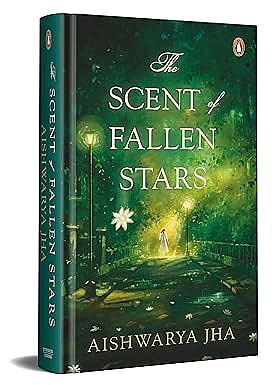Travels through Time

Aishwarya Jha’s heart-warming debut novel The Scent of Fallen Stars is a paean to the bonds we share, which anchor us to an alienating and unpredictable world. The narrative evokes a melange of senses and emotions that sets the reader on a journey of love, loss and longing.
Straddling two timelines, 1995–96 and 2018, the novel is about the characters’ quest to discover the meaning of home. In 1995–96, Will Rhodes, an expat in a newly liberalised India falls in love with the enigmatic Leela, an orphan living in Delhi. Unfortunately, fate has other plans for her, as she is promised to Samir. But then Samir abandons a pregnant Leela, because his family does not wish for him to marry a rootless orphan who has no prospects for dowry. Grief-stricken and betrayed, Leela abandons her daughter at a hospital and runs away to an ashram. Aria, her daughter, is later raised by Will. In 2018, Aria visits Delhi to find her mother and the truth of her own past.
Jha writes the parallel but distinct narratives deftly. With its many revelations and twists, the novel proves to be unputdownable. Love can be complex and debilitating, but it is also the most regenerative of forces. As Will falls deeper in love with Leela in 1995, Jha writes eloquently about the wistful realities of unrequited love, while also exploring the restorative qualities of love.
Another strength of the novel is its dialogue. In one scene, Jha describes a philosophical exchange at an ashram. While the Guruji’s sermons could easily have fallen into syrupy didacticism, Jha keeps the language and ideas sharp and disciplined. In various other emotionally charged scenes, the writing is non-dramatic. The characters talk with assuredness and curiosity; they listen to each other even in moments of conflict.
2026 New Year Issue
Essays by Shashi Tharoor, Sumana Roy, Ram Madhav, Swapan Dasgupta, Carlo Pizzati, Manjari Chaturvedi, TCA Raghavan, Vinita Dawra Nangia, Rami Niranjan Desai, Shylashri Shankar, Roderick Matthews, Suvir Saran
Jha’s novel is rooted in Delhi, and she writes with conviction about the bustling city. Qutub Minar through Aria’s eyes is described as, “Intricate balconies wrapped around the tower like crowns on a pedimented display.” From the scenic Lutyens’ Delhi in spring to midnight reveries in Lodhi Gardens, the descriptions of the city’s rapidly receding histories are visceral.
Jha often inserts Urdu-Hindustani words to anchor her own modern story, and to hark back to the literary history of the city, buried under “indistinguishable palimpsests.” The chapter where the truth about Leela’s pregnancy is revealed is subtitled haqeeqat (truth) and the book is gracefully peppered with translated shers from Mir and Ghalib.
Perhaps Jha uses the city as a character too. In contrast to the swift decay of the characters’ bodies and memories, the city’s sense of slow ageing builds a connection amongst them. It is as if they can always return to each other, as long as Delhi’s pillars in Connaught Place remain standing.
As the novel’s title suggests, the corporeal and the spiritual co-exist in the narrative. At times, the novel risks crossing into magic realism with its transportive language of senses. When Will first meets Leela under the midnight moon, the scent of the maulsari flower elates him. Leela is described as someone who walks in the air… Her aura is enchanting like an angel’s: “A small figure in all white, floating along the street in her reverie, humming to herself… She wasn’t aware the universe was arranging itself around her, merely a stage for her meteoric presence.”
Jha has a worldly explanation for all these otherworldly descriptions: love. Love is lightness and levitation, and if removed from its burdens like jealousy, control, obsession, it is the purest, most accessible form of magic that we are capable of. This thesis is also the heart of Jha’s rewarding, reassuring and tender novel.

